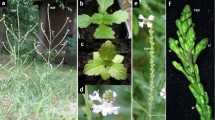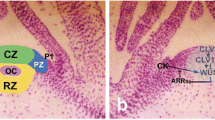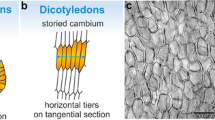Abstract
After a critical evaluation of the concept of dichotomous branching in Cormophytes the shoot apical meristems ofPsilotum triquetrum andSelaginella speciosa are described. InPsilotum only the terminal meristems of the cryptophilic shoots have a three sided apical cell. Those of the photophilic shoots lack a typical apical cell.Selaginella has a two sided apical cell. The process of branching is independent from apical cells. It is due to an equal or unequal fractionation of the initial zone of the shoot apex which embraces all tissues above the leaf producing zone of the apical meristem.
Similar content being viewed by others
Literatur
Banks, H. P., 1968: The early history of land plants. — InDrake, E. T., (Ed.): Evolution and Environment, 73–107. — New Haven and London: Yale Univ. Press.
—, 1970: Evolution and Plants of the Past. — Belmont, Calif.: Wadsworth.
Bierhorst, D. W., 1971: Morphology of Vascular Plants. — New York: Macmillan.
—, 1973: Non appendicular fronds in theFilicales. — Bot. J. Linn. Soc.67, Suppl. I, 45–57.
Bower, F. O., 1908: The Origin of a Land Flora. — London: Macmillan.
—, 1935: Primitive Land Plants. — London: Macmillan.
Bruchmann, H., 1897: Untersuchungen überSelaginella spinulosa A. Br. — Gotha: F. A. Perthes.
Freeberg, J. A., Wetmore, R. H., 1967: TheLycopsida — a study in development. — Phytomorphology17, 78–91.
Gensel, P. G., Andrews, H. N. &Forbes, W. H., 1975: A new species ofSawdonia with notes on the origin of microphylls and lateral sporangia. — Bot. Gaz.136, 50–62.
Gerstenberger, P., Leins, P., 1978: Rasterelektronenmikroskopische Untersuchungen an Blütenknospen vonPhysalis philadelphica (Solanaceae). Anwendung einer neuen Präparationsmethode. — Ber. Deutsch. Bot. Ges.91, 381–387.
v. Guttenberg, H., 1966: Histogenese der Pteridophyten. In Handbuch der Pflanzenanatomie 2. Aufl. Bd. 7, Teil 2, Abt. Spezieller Teil. — Berlin: Borntraeger.
Hagemann, W., 1970: Studien zur Entwicklungsgeschichte der Angiospermenblätter. Ein Beitrag zur Klärung ihres Gestaltungsprinzips. — Bot. Jahrb.90, 297–413.
—, 1978a: Zur Phylogenese der terminalen Sproßmeristeme. — Ber. Deutsch. Bot. Ges.91, 699–716.
—, 1978b: II. Morphologie und Anatomie der höheren Pflanzen. a) Vergleichende Morphologie des Vegetationskörpers einschließlich der Blüten. — Fortschr. Bot.40, 35–55.
Hagemann, W., Schulz, U., 1978: Wedelanlegung und Rhizomverzweigung bei einigen Gleicheniaceen. — Bot. Jahrb.99, 380–399.
Holloway, J. E., 1939: The gametophyte, embryo and young rhizome ofPsilotum triquetrum Swartz. — Ann. Bot. (N. S.)3, 313–336.
Kaplan, D. R., 1977: Morphological status of the shoot systems ofPsilotaceae. — Brittonia29, 30–53.
Mollenhauer D., Hagemann, W., (im Druck): Ein Modell für die Entwicklung der grünen Landpflanzen. — Courier Forschungsinst. Senckenberg15, Frankfurt/Main.
Rouffa, A. S., 1978: On phenotypic expression, morphogenetic pattern and synangium evolution inPsilotum. — Am. J. Bot.65, 692–713.
Russow, E., 1875: Betrachtungen über das Leitbündel und das Grundgewebe aus vergleichend morphologischem und phylogenetischem Gesichtspunkt. — Dorpat: Mattiesen.
Sachs, J., 1874: Lehrbuch der Botanik. 4. Aufl. — Leipzig: Engelmann.
Siegert, A., 1964: Morphologische, entwicklungsgeschichtliche und systematische Studien anPsilotum triquetrum SW. I. Allgemeiner Teil: Erstarkung und primäres Dickenwachstum der Sprosse. — Beitr. Biol. Pfl.40, 121–157.
—, 1965: Morphologische, entwicklungsgeschichtliche und systematische Studien anPsilotum triquetrum SW. II. Die Verzweigung (mit einer allgemeinen Erörterung des Begriffes „Dichotomie“). — Beitr. Biol. Pfl.41, 209–230.
—, 1974: Die Verzweigung der Selaginellen unter Berücksichtigung der Keimungsgeschichte. — Beitr. Biol. Pfl.50, 21–112.
Solms-Laubach, H., 1884: Der Aufbau des Stockes vonPsilotum triquetrum und dessen Entwicklung aus der Brutknospe. — Ann. Jard. Bot. Buitenzorg4, 139–194.
Troll, W., 1937: Vergleichende Morphologie der höheren Pflanzen1, 1. Teil. — Berlin: Borntraeger.
Zimmermann, W., 1959: Die Phylogenie der Pflanzen. 2. Aufl. — Stuttgart: G. Fischer.
—, 1965: Die Telomtheorie. — Stuttgart: Fischer.
—, 1969: Geschichte der Pflanzen. — Stuttgart: Thieme-Verlag.
Author information
Authors and Affiliations
Additional information
Herrn Univ.-Prof. Dr.Walter Leinfellner zum 70. Geburtstag gewidmet.
Rights and permissions
About this article
Cite this article
Hagemann, W. Über den Verzweigungsvorgang beiPsilotum undSelaginella mit Anmerkungen zum Begriff der Dichotomie. Pl Syst Evol 133, 181–197 (1980). https://doi.org/10.1007/BF00984379
Received:
Issue Date:
DOI: https://doi.org/10.1007/BF00984379




